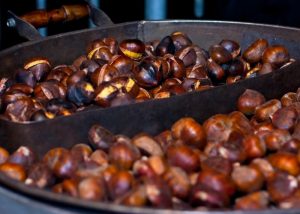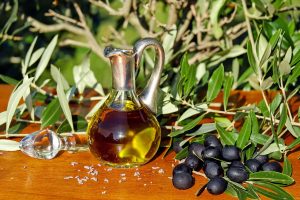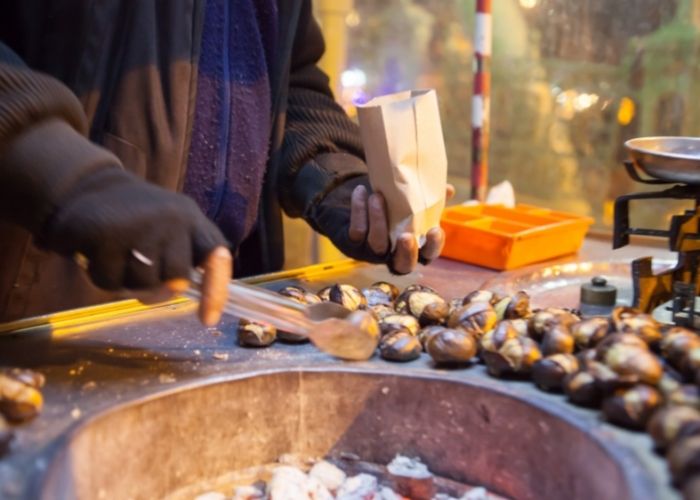Even though the sun almost always shines in Spain, the country does have seasons. Autumn has just begun and is as varied as Spain itself.
Rust-brown coloured forests, deserted beaches, the smell of roasted chestnuts in the streets of Spanish cities, heavy rain showers, cheerful harvest festivals, or the smell of wood stoves that have to dispel the first cold. From a culinary point of view, it is the season of chestnuts, truffles, olives, and grapes.
Chestnuts
All over the Spaish landscape chestnut trees are growing. Their fruits, the castañas, were the staple food in northwestern Spain because of their nutritiousness and abundant availability. That was until potatoes and corn from the New World knocked them out of place. However, people still widely use chestnuts as a side dish with pork, turkey, and game. For example, in Galicia, you will find them in soups, stews, and pastries. And from October, throughout Spain, the first stalls appear on street corners where freshly roasted chestnuts spread their typical Spanish autumn air. At the beginning of November, Spanish regional calendars are filled with chestnut festivals where the harvest is celebrated with lots of food and campfires.

Roast Chestnuts
Roast chestnuts yourself
Roasting chestnuts in the fireplace or in a pan is very easy. Cut a cross in the top of the chestnuts and place in the glowing charcoal or in a pan of melted butter until they pop. Take them out of the heat, let them cool, and peel them. In the pan, it takes about 20 minutes on medium heat.
Truffles
Trufas, wild black truffles grow deep in the ground around oaks, hazelnut trees, and pines. These are mainly found in the wooded mountains in the north and in Valencia. Truffles are the jewels of the forest. Together with saffron, the truffle is the most precious and exclusive culinary product in the world. The truffle was never really important in Spanish cuisine and was mainly exported to France. Because they are now also grown here and there in Spain, the locals and chefs in the area use them to add something unique to their dishes.
Related post: 7 Cities in Spain for your autumn trip
For fresh truffles, it is best to visit the special truffle markets that are available in the season between December and March. The most important is the Olot market in the province of Girona, in Vic en Centelles in the province of Barcelona, and in Solsona in Lleida. You can also go to the truffle fair in Teruel in the first week of December.
Search for truffles yourself
You can also go truffle hunting yourself with a truffle tracking dog, a shovel and good walking shoes. The greatest chance of finding is on sunny slopes at an altitude of 300 to 1,500 meters with calcareous soil where it rains on average. Wherever people can find truffles, the local tourist industry organises guided tours.
Olives
The olive harvest takes place from November to February, depending on the variety. Spain is the largest producer of olive oil in the world. 60% of the olive trees in Andalucia are in the provinces of Jaén and Córdoba. Olive trees have deep roots, require little water, and therefore thrive in the Mediterranean climate. For oil of very good quality, such as the Extra Virgen (oil with low acidity and full taste and aroma), only intact and ripe olives are suitable. These must be processed within 72 hours of harvesting. The traditional way of harvesting, in which one hits the branches with long sticks, is called ‘vareo’. The ripe fruits fall into nets spread under the trees.

However, for the best oil, farmers and their workers pick olives by hand. Today, bulk production is harvested with shakers. For table olives, each region has its own way of flavouring the olives for its own consumption. For example with garlic and herbs or, as in Andalusia, with vinegar. These manzanilla olives from Seville and Cádiz are the most popular green olives in the world.
Make your own olives
Anyone who has ever put an olive straight from the tree into his mouth knows that you will be disappointed. They are very bitter. Pickling olives yourself takes a lot of time but is otherwise quite simple. Score the olives with a shallow cross in the skin and place them in a sealed plastic bottle in water that you change every day for ten days. After ten days the olives can be put in the salt. For this, you use 100 grams of salt for every kilo of olives that you dissolve in water. Add the olives and let them stand in the brine for about a month. To taste you can add garlic, lemon slices, red peppers, or other herbs at the end.
Grapes
Spain is the country with the largest amount of land on which vines grow in the world. From a producer of cheap, unobtrusive, anonymous bulk wines, the country is now becoming the most promising and exciting country for quality wines. Today, almost every region in Spain produces wines with their own character. Wine tourism is also a growing industry and everywhere in the wine regions v Ind your wine routes and you can visit bodegas for extensive tastings.
Related post: Twelve of the best Spanish beaches to visit in autumn
Winegrowers harvest most grape varieties in the fall. In most areas, this happens around September before the autumn rains set in. In many places, wine companies will be amply busy pressing and bottling their wines until far in September. People in many places also celebrate the harvest of grapes. The most famous is probably the feria de Vendimia in Jerez de la Frontera. When other places in Spain still were still producing bulk wines, this place was already famous for the sherries produced there.
Spanish autumn wine
Vineyards are particularly beautiful in the fall when all the grape leaves have shades of red-bronze, golden yellow, and orange-brown abundance and make summer seem long ago. Take a walk and take in your picnic basket a delicious, round, deep red Spanish autumn wine, which tastes of ripe fruit, nuts, and vanilla. The Spanish regions of La Rioja and Ribera del Duero are especially renowned for their tasty red wines. But especially given the red wines from other D.O.s a chance.


